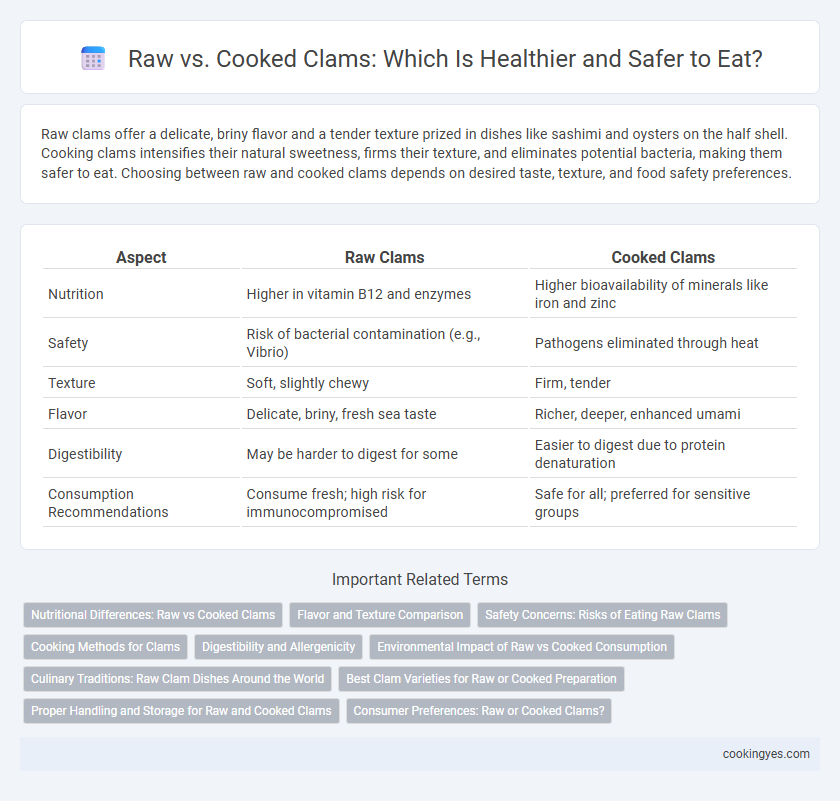Raw clams offer a delicate, briny flavor and a tender texture prized in dishes like sashimi and oysters on the half shell. Cooking clams intensifies their natural sweetness, firms their texture, and eliminates potential bacteria, making them safer to eat. Choosing between raw and cooked clams depends on desired taste, texture, and food safety preferences.
Table of Comparison
| Aspect | Raw Clams | Cooked Clams |
|---|---|---|
| Nutrition | Higher in vitamin B12 and enzymes | Higher bioavailability of minerals like iron and zinc |
| Safety | Risk of bacterial contamination (e.g., Vibrio) | Pathogens eliminated through heat |
| Texture | Soft, slightly chewy | Firm, tender |
| Flavor | Delicate, briny, fresh sea taste | Richer, deeper, enhanced umami |
| Digestibility | May be harder to digest for some | Easier to digest due to protein denaturation |
| Consumption Recommendations | Consume fresh; high risk for immunocompromised | Safe for all; preferred for sensitive groups |
Nutritional Differences: Raw vs Cooked Clams
Raw clams retain higher levels of vitamin B12 and certain heat-sensitive antioxidants, offering superior nutrient density compared to cooked clams. Cooking clams increases protein bioavailability and enhances mineral absorption, particularly iron and zinc, though some water-soluble vitamins may degrade during heat exposure. Balancing raw and cooked clam consumption maximizes intake of essential nutrients such as omega-3 fatty acids, potassium, and selenium while minimizing potential foodborne risks.
Flavor and Texture Comparison
Raw clams deliver a briny, fresh flavor with a tender, slightly chewy texture that highlights their natural oceanic taste. Cooked clams develop a milder, sweeter flavor profile and a firmer texture, often becoming more tender and easier to chew. The choice between raw and cooked clams significantly affects the sensory experience, with raw clams offering a more intense, pure taste and cooked clams providing enhanced richness and comfort.
Safety Concerns: Risks of Eating Raw Clams
Consuming raw clams poses significant safety concerns due to potential contamination with harmful bacteria such as Vibrio vulnificus, which can cause severe infections. Raw clams may also harbor viruses like norovirus, increasing the risk of gastrointestinal illness. Cooking clams thoroughly at temperatures above 145degF (63degC) effectively eliminates these pathogens, ensuring safer consumption.
Cooking Methods for Clams
Steaming and boiling are the most effective cooking methods for clams, ensuring they open naturally and release flavorful juices while eliminating harmful bacteria. Baking and grilling provide a smoky taste by exposing clams to direct heat, which enhances texture without overcooking. Avoid raw consumption unless clams are sourced from highly regulated suppliers, as raw clams pose a higher risk of Vibrio infection.
Digestibility and Allergenicity
Raw clams contain natural enzymes that aid digestion but pose a higher risk of harboring bacteria and parasites, potentially increasing allergenic reactions in sensitive individuals. Cooking clams denatures proteins, reducing allergenicity and improving digestibility by breaking down tough muscle fibers. Steam or boil clams at 145degF (63degC) for at least 3-5 minutes to ensure food safety while enhancing nutrient absorption.
Environmental Impact of Raw vs Cooked Consumption
Consuming raw clams significantly reduces energy consumption compared to cooked clams, as cooking processes like boiling or steaming require substantial fuel or electricity resources. Raw clam consumption also minimizes carbon emissions associated with cooking appliances, contributing to a lower overall environmental footprint. However, proper sourcing and handling are essential to avoid health risks, ensuring sustainability and safety in raw clam consumption.
Culinary Traditions: Raw Clam Dishes Around the World
Raw clam dishes showcase diverse culinary traditions, with popular examples including Japanese sashimi, where thinly sliced clams highlight their fresh, briny flavor, and Italian vongole crudo, featuring marinated raw clams with citrus and herbs. In the Pacific Northwest of the United States, Native American tribes consume raw clams with minimal seasoning to preserve natural taste and texture. These global culinary practices emphasize raw clams' delicate sweetness and tender consistency, often complemented by simple, acidic, or herbal accompaniments.
Best Clam Varieties for Raw or Cooked Preparation
Tender littleneck clams and sweet cherrystone clams are prized for raw consumption, offering a fresh, briny flavor that highlights their natural sweetness. Larger quahog clams and robust razor clams are better suited for cooked preparations, as heat enhances their chewy texture and deepens their earthy taste. Choosing the right clam variety ensures optimal flavor and texture whether served raw on the half shell or steamed in a savory dish.
Proper Handling and Storage for Raw and Cooked Clams
Proper handling and storage of raw clams require keeping them in a breathable container at temperatures below 40degF (4degC) to prevent bacterial growth and maintain freshness. Cooked clams should be refrigerated within two hours of cooking in an airtight container and consumed within three to four days to ensure safety and quality. Avoid freezing live clams, but cooked clams can be frozen for up to three months to extend shelf life while preserving taste and texture.
Consumer Preferences: Raw or Cooked Clams?
Consumer preferences for clams vary widely, with many favoring raw clams for their fresh, briny flavor and tender texture, often enjoyed in dishes like raw clam cocktails and sushi. Cooked clams appeal to those seeking enhanced safety and deeper, milder flavors, commonly featured in clam chowder, steamed clams, and pasta dishes. Factors influencing choice include regional culinary traditions, health considerations, and individual taste preferences toward texture and flavor intensity.
Raw vs Cooked for clam consumption Infographic

 cookingyes.com
cookingyes.com